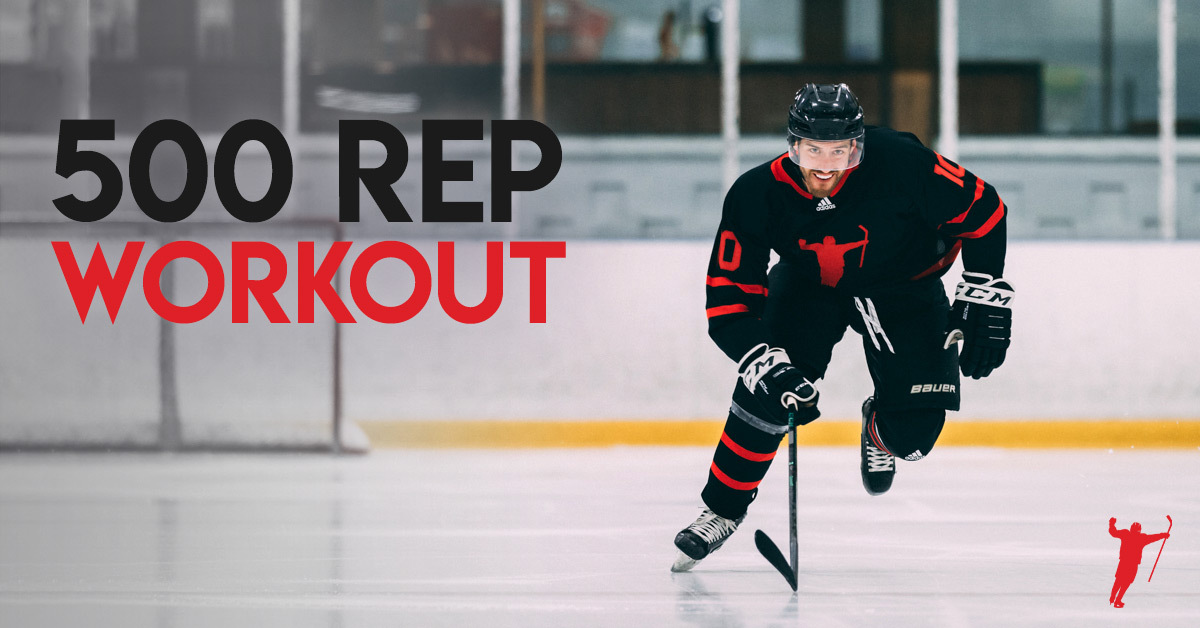Hockey players are tough, both mentally and physically.
They train many hours every single week—and do so for years on end. When you do this for long enough, at some point you’re going to want to throw in what I refer to as a “rattlesnake workout.”
I can’t remember exactly how I coined that term, but it has stuck, and my hockey players both love and hate the expression. My rattlesnake workouts represent an extreme challenge that doesn’t negate the current goal of the athlete.
For example, if the goal of the current phase is to build functional muscle tissue, the rattlesnake workout would be a very difficult, challenging workout—but it would still have an emphasis on muscular development. In another example, if an athlete wanted more conditioning, my rattlesnake workout for them would be an extremely difficult challenge, but still emphasize a hockey-specific conditioning training stimulus.
In essence, a rattlesnake workout is an extreme challenge with many benefits:
- It builds mental toughness
- It gives a hockey player a break from their current program
- Completing the challenge boosts a player’s confidence
- The extreme training stimulus helps them get over their current training plateau
- It gives the crazy ones something fun to do
Where many coaches go wrong in their challenge workouts is that they are usually just something that looks “hardcore” for social media but lacks training specificity.
For example, a coach will have their players run suicides until they puke, even though the goal of the program was muscle building, or swing battle ropes around like crazy, even though it’s not hockey-specific.
My rattlesnake workouts offer a plateau-busting challenge, but stay true to the principles of programming so that you’re always becoming a better hockey player.
I have many rattlesnake workouts in my mad scientist brain, but the one I am going to present to you today is The 500-Rep Hockey Workout.
Basic Breakdown
The idea is simple: choose five exercises and do 100 reps of each over the course of the workout.
The goal is to train the entire body, so I don’t want you to select all presses, or all pulls, or all legs. Here’s an example of how to keep it balanced:
- Vertical press
- Vertical pull
- Horizontal press
- Horizontal pull
- Lower body
Your objective is to hit as many major muscle groups as you can within your five exercise choices. Using the above format, you could choose:
- Neutral grip overhead DB press
- Wide pronated grip lat pulldown
- Flat BB bench press
- Chest supported two-arm DB row
- Goblet Squats
If you choose exercises such as supinated grip chin-ups and dips, your biceps and triceps will get fried too.
If you are seeking a greater leg focus, you could divide your leg work up with an exercise for hamstrings, an exercise for quads, and an exercise for glutes. It takes a little bit away from the total body aspect, but if your other two exercises were a clean and press plus a pull-up, you would cover your total body anyways.
You’re only limited by your own creativity when it comes to designing this rattlesnake workout. Trust me, you want to think it through before you do 500 reps or the bite from this snake might be too much for you to survive.
Set and Rep Distribution
The way in which you structure your set and rep distribution is going to determine the goal of the workout.
Straight sets, supersets, circuits, or even going for time will all yield very different responses from your physiology.
The beautiful thing about this particular rattlesnake is that it’s a rep-based challenge, which means you get to choose how you achieve those reps, and in turn, you get to choose what you want out of the workout.
Below are a few of my favorite variations that I know you’re going to love.
The Technique Builder
This is an excellent variation to use if you want to build work capacity, learn a new movement, or really “lock-in” a new technique into your automatic movement patterns.
For these reasons, it’s a perfect option for a youth hockey player who is just beginning to use weights for the first time, or an adult hockey player who is learning an exercise they have never done before.
You will perform an “ascending set pattern,” where you will increase weight every set or every other set. Sets of 10 work perfectly here.
Here’s an example of what one exercise in your plan could look like:
20lbs x 10 reps x 2 sets
25lbs x 10 reps x 2 sets
30lbs x 10 reps x 2 sets
35lbs x 10 reps x 2 sets
40lbs x 10 reps x 2 sets
That’s 100 reps, and you would use this same ascending pattern for the other four exercises as well to complete 500 total reps.
Functional Muscle Circuit
Most people think of circuits exclusively being used to create a conditioning effect; however, rattlesnakes don’t care about your preconceived opinions and do whatever they want to do to create plateau-busting chaos inside your physiology.
So long as the intensity and rep range is on point, there is absolutely no reason you can’t use a total body circuit to build muscle mass. I particularly love this variation because it’s fun, effective, and doesn’t take forever to complete since the pace is very high.
Start light and add a little bit of weight each round. Your first two rounds should feel like a good warm-up, and your remaining eight rounds should feel like legit muscle-building tension sets.
- Neutral grip overhead DB press x 10 reps
- Wide pronated grip lat pulldown x 10 reps
- Flat BB bench press x 10 reps
- Chest supported two-arm DB row x 10 reps
- DB goblet squat x 10 reps
Rest two minutes between circuits and repeat for ten total rounds.
Bodyweight-Only Killer Conditioning Blast
This variation borrows a concept from CrossFit in that I want you to time the entire workout.
You can break the sets and reps up any way you want, but for the purpose of conditioning, I love using five sets of twenty for each exercise. This means you would perform all five sets of twenty of a certain exercise before moving on to the next one.
I find the high-rep nature of the movement pattern drives a ton of conditioning and work capacity benefits all by itself, but the added pressure of being timed forces you to keep your rest periods short and really crank things up a notch.
- Push-ups: 5 x 20
- Prisoner squats: 5 x 20
- Inverted row: 5 x 20
- Hip thrust: 5 x 20
- Bulgarian split squats: 5 x 10/leg
Start a clock when you begin your first rep and let it run until you complete your 500th rep. Rest only when necessary, but know the clock is still running and your goal is to finish as fast as possible. This forces you to move quickly, which builds your work capacity and burns a ton of calories.
Then write your finishing time down so you can attempt to beat it the next time you try this challenge.
Final Thoughts
The above 500-Rep Hockey Workout variations are some of the most common ways I use this rattlesnake in my programming to keep things fresh, fun, and progressive for my hockey players.
However, the variations are endless. You can use this type of structure to create any result, so ensure you don’t veer too far away from the goal of your existing program design by thinking you need to stick exactly to the above templates.
I recommend this only be performed in the off-season, and twice per month at the absolute most. I only recommend it be performed once or twice per month because the foundation of your hockey training should always be set in a complete and periodized hockey training program design.
Biology responds to averages over time, and that’s why every hockey player reading this needs to be on a real hockey training program year-round and only use these challenges as a psychological and physiological plateau-buster when you really need it.
To get the best results possible, join the Hockey Training team today, and let’s take you to the next level!


How would I use this if I’m currently on the isd training plan?
Bookmark it for the off-season! We don’t recommend this for the in-season.
Alright sweet thanks coach!